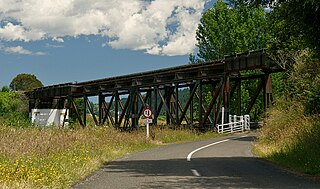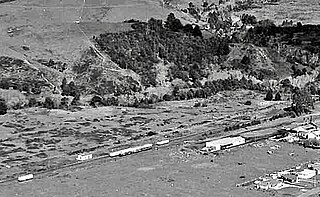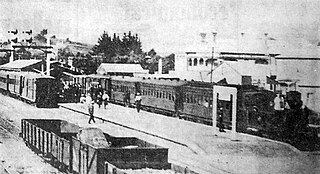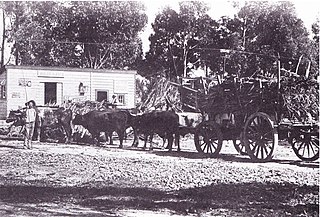
Kawakawa is a small town in the Bay of Islands area of the Northland Region of New Zealand. Kawakawa developed as a service town when coal was found there in the 1860s, but coal mining ceased in the early 20th century. The economy is now based on farming. The town is named after the kawakawa shrub.

The North Auckland Line is a major section of New Zealand's national rail network, and is made up of the following parts: the portion of track that runs northward from Westfield Junction to Newmarket Station; from there, westward to Waitakere; from there, northward to Otiria via Whangārei. The first section was opened in 1868 and the line was completed in 1925. The line, or sections of it, have been known at various times as the Kaipara Line, the Waikato-Kaipara Line, the Kaipara Branch and the North Auckland Main Trunk.

The Opua Branch or Otiria-Opua Industrial Line, partially still operational as the Bay of Islands Vintage Railway, is a former section of the North Auckland Line in the Northland Region of New Zealand, between Otiria and the Bay of Islands township of Opua. The first section was constructed as a bush tramway in 1867 and converted to a railway in the next decade. Today the railway is partially used by the Bay of Islands Vintage Railway, which runs tourist services between Kawakawa and Te Akeake. The line's centrepiece is the section where it runs down along the main street of Kawakawa.

The Stillwater Ngākawau Line (SNL), formerly the Stillwater–Westport Line (SWL) and the Ngakawau Branch, is a secondary main line, part of New Zealand's national rail network. It runs between Stillwater and Ngakawau via Westport on the West Coast of the South Island. It was one of the longest construction projects in New Zealand's history, with its first section, at the south end, opened in 1889, and the beginnings of the Ngākawau Branch, at its Westport end, in 1875. The full line was completed in 1942. The only slower railway projects were Palmerston North to Gisborne, 1872 to 1942, and the Main North Line to Picton, 1872 to 1945.

The Stratford–Okahukura Line (SOL) is a secondary railway line in the North Island of New Zealand, between the Marton - New Plymouth Line (MNPL) and the North Island Main Trunk (NIMT) Railway, with 15 intermediate stations. It is 144 km (89 mi) long through difficult country, with 24 tunnels, 91 bridges and a number of sections of 1 in 50 grade. Near Okahukura there is an unusual combined road-rail bridge over the Ongarue River, with the one-lane road carriageway below the single rail track. The line is not currently in service for rail traffic and is under a 30-year lease for a tourist venture. In July 2019 KiwiRail's CEO stated that reopening the line was a priority. Minister of Transport Michael Wood announced the government's 10-year plan for rail investment on 6 May 2021, which specifically stated that plans could include re-opening the Stratford to Okahukura line.

The Bay of Islands Vintage Railway Trust (BOIVRT) is a heritage railway in Kawakawa, in Northland, New Zealand. The railway operates on part of the former Opua Branch railway.

The Thames Branch railway line connected Thames, New Zealand, with Hamilton and was originally part of the East Coast Main Trunk railway. Part of the line between Morrinsville and Waitoa remains open and is in use as the Waitoa Branch line, connecting to the Fonterra Dairy Factory at Waitoa.
The Ngatapa Branch was a secondary branch line railway 18.5 kilometres (11.5 mi) long that for a short time formed part of the national rail network in Poverty Bay in the North Island of New Zealand. The Ngatapa branch diverged from the Moutohora branch line about 6 kilometres (3.7 mi) from Gisborne and ran a further 12.5 kilometres (7.8 mi) across the coastal flat to a terminus at Ngatapa. It was sometimes referred to as the Ngapata branch.

Otiria railway station was a station on the North Auckland line in New Zealand, at its junction with the Ōkaihau and Opua Branches, at Otiria. It is now KiwiRail's most northerly station, though mothballed since 2016.

Kawakawa railway station was a station on the Opua Branch in New Zealand. and is the terminus of the Bay of Islands Vintage Railway (BoIVR) in the small town of Kawakawa. It was also the terminus of the oldest railway on the North Island, opened in 1867, before being joined to the rest of the North Auckland Line in 1912.

Taumarere railway station was a station on the Opua Branch in New Zealand and is a stop on the Bay of Islands Vintage Railway near Taumarere village. It is on the oldest railway built on the North Island, which opened in 1867. Taumarere station has had three locations, east of the village, west of the village and at the rugby ground.

Moerewa railway station was a flag station at Moerewa on the Opua Branch of the North Auckland Line in New Zealand.

Mercer railway station in Mercer, New Zealand, is 72 km from Auckland and 609 km from Wellington on the North Island Main Trunk line. It opened on 20 May 1875 and was closed to passengers about 1970 and to goods in the 1990s. It burnt down in 1879 and also in 1900. Until 1958 it was the first refreshment stop south of Auckland.
The Paeroa-Pōkeno railway line or deviation in the upper North Island of New Zealand between Paeroa on the East Coast Main Trunk (ECMT) and Pōkeno on the North Island Main Trunk (NIMT) was a proposed route with construction started but abandoned. The proposal has been revived in recent years as part of a more direct route between Auckland and Tauranga.

Paeroa railway station is a former railway station in Paeroa; on the Thames Branch, and on the East Coast Main Trunk Railway to Waihi. Between 1895 and 1991 Paeroa had a station at the north end of the town centre, followed by one further north, another back near the town centre and then another over a mile south of the town.

Te Kauwhata was a flag station on the North Island Main Trunk line, in the Waikato District of New Zealand, 54 mi (87 km) south of Auckland. It was 591.52 km (367.55 mi) north of Wellington, 3.32 km (2.06 mi) north of Rangiriri, 6.72 km (4.18 mi) south of Whangamarino and 12 m (39 ft) above sea level.

Horopito was a station on the North Island Main Trunk line, in the Ruapehu District of New Zealand. It served the small village of Horopito and lies just to the north of two of the five largest NIMT viaducts. It and Pokaka also lay to the south of Makatote Viaduct, the late completion of which held up opening of the station.

Opaparailway station is a preserved station on the Palmerston North–Gisborne Line in New Zealand's North Island that closed in 1981. It is in the Hastings District of Hawke's Bay, 23.56 km (14.64 mi) south of Hastings city, in a census meshblock with a population of only 222 in 2018.

Matamau is a small village, on a ridge between the Matamau and Whakaruatapu Streams, tributaries of the Manawatū River, in the Manawatū-Whanganui region of New Zealand's North Island. State Highway 2 and the Palmerston North–Gisborne line run through the village. It has a rare surviving example of a basic railway station, a cafe, developed from the former post office and store about 1969, and a truck repair workshop. Until the 1870s it was densely forested, but most of the trees were felled and milled by 1910 and replaced by farms.

Pou Herenga Tai – Twin Coast Cycle Trail is one of 23 Great Rides in New Zealand. It is an 87 km (54 mi) cycleway in Northland, North Island, fully opened at the end of 2016. At the eastern end, part of the main route involves travelling on the Bay of Islands Vintage Railway (BoIVR), rather than cycling, or walking.





















